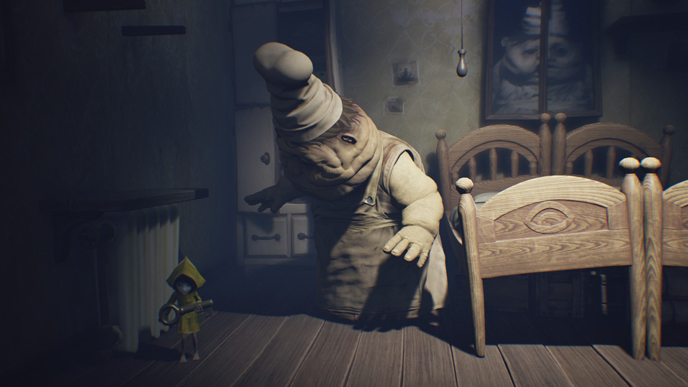
In Dante Alighieri’s The Divine Comedy, Dante and Virgil—a Roman poet and Dante’s guide—journey through the nine circles of Hell in search of deliverance, reprieve, and salvation for Dante’s soul. While traveling through this underworld, the two poets stumble into the third circle of Hell, filled with excrement and filth. This circle, this desolate and bleak wasteland, is home to the gluttonous, those who overindulge: eating, drinking, coitus, you name it. These hapless souls must live the rest of eternity trapped in this location while filth rains upon them; should they try to escape, the three-headed dog, Cerberus, tears their body apart. (They respawn only to repeat this unfortunate life perennially.) Tarsier Studios’ Little Nightmares presents us with the third circle of Hell, wrapped into a Tim Burton-esque package comparable to PlayDead’s Limbo or Inside. In Little Nightmares, these nightmares are grotesque and terrifying.
Clad in a yellow raincoat, you play as Six, a short, starved, little person (not a midget), navigating through a ship known as The Maw. This ship is populated by the gluttonous: obese, overindulgent people obsessed with stuffing their face with anything and everything they can find—including you. Ever trying to escape both the clutches of these incessantly hungry people and The Maw itself, you solve puzzles, jump and climb around, unlock doors, and ascend the ship, hoping to not slosh around the insides of someone’s intestines.
Little Nightmares’ narrative is told through the environment, metaphors, and symbolism. In essence, to say there is a coherent narrative here is false: this is another one of those open-to-interpretation titles in the same vein as Inside. And while that might be the case, Tarsier Studios has crafted a hauntingly provocative story with its use of atmosphere, cultural themes (by way of geisha culture), and fear of the unknown. Little Nightmares sends chills through your spins as you attempt to outrun people much larger—and thus, much faster—than you. This narrative, however provocative, is esoteric and obtuse; in truth, you play Little Nightmares for its gameplay, not its story.
The game is a 2.5D side-scrolling puzzle platformer, so jumping around and climbing everything is expected. Six controls smoothly and with a surprising amount of heft for someone of her stature. Because of her alarmingly heavy physics, platforming with Six is satisfying as each action is laborious and requires precision timing to perform, lest you get munched on. Unfortunately, because the The Maw is a 2.5 dimensional space, it can be cumbersome figuring out exactly where you are: falling to your death or sliding into a wall instead of a hole will occur far more often than your own mistake. Eventually, you’ll understand the strange place you’re in, but by that time, the game is suddenly over.
It’s a shame the game ends so suddenly because it is rife with dread, suspense, tension. While exploring The Maw and figuring out where the nearest exit is, you encounter a variety of monstrously repulsive, despicably deformed people who want nothing more than to chop your little body up and serve you to the denizens of the ship—or chow down on you themselves. Playing to our fear of the unknown, Tarsier Studios effectively use shadows, deceptive camera angles, and lack of distinctive soundtrack to heighten the tension in the game. Chase sequences are more frightening than they should be, due to well-placed camera angles obscuring the pursuer as well as subtle light illuminating portions of the path in front of you. Save for your infinitely-fueled lighter, the path ahead is almost always shrouded in a thick blackness, making Little Nightmares quite nightmare inducing.
Six slowly becomes incapacitated by a grumbling stomach at certain points during the journey through The Maw. In each of these junctions, she devours something larger as the game progresses, starting with what looks to be a piece of meat. to a rat, and beyond. As you reach the conclusion of the game, you realize The Maw is metaphor for gluttony. Merriam-Webster defines maw as “the throat, gullet, or jaws especially of a voracious animal.” By the end of it all, Six becomes the voracious animal, devouring anything and everything in her path. Little Nightmares is a vicious cycle where the prey becomes the predator, and an effective one at that.
Little Nightmareswas developed by Tarsier Studios and published by Bandai Namco Entertainment. Our review is based on the PlayStation 4 version. It is also available for PC and Xbox One.
Jeremy Winslow is a Californian critic and essayist with big glasses who furiously types into WordPress and yells into the ether. He’s written for Feminist Frequency, GameSpot and more, and co-launched the small entertainment website Ground Punch. Listen to him yell on Twitter. Or don’t. That’s fine.
